Brendan Kennelly
Katelyn Ferguson
Beginning with the publication of Cast a Cold Eye (with Rudi Holzapfel) by Dolmen Press in 1959, Brendan Kennelly has produced more than thirty collections of poetry. He has also written novels and plays; translated and produced versions of works in Irish, Spanish, Latin, and Greek; and seen his writing adapted into pieces for the concert hall and stage. He has served as literary critic, editor, and anthologist; commented for print and television media on sports and culture; and reworked his own material for republication in new forms. For more than forty years a member of the School of English at Trinity College Dublin where he was Professor of Modern Literature, Kennelly has taught at universities across North America and Europe; spoken at hospitals, secondary schools and business management conferences; been interviewed on television chat shows; and performed his poetry widely. In 2010 he was awarded the Irish PEN Award for Contribution to Irish Literature.
In his most widely discussed poem sequences, anthologies, and collections, Kennelly’s method has been to combine apparently disparate perspectives in service to a larger theme or themes. This has made him a writer who is particularly well suited to tell the stories of modern Ireland during a period of significant social change. As artist, teacher, and cultural commentator Kennelly has produced works that interrogate the legacy of Ireland’s colonial history, the place of religion in contemporary culture and politics, gender, language, and the role of poets and artists. If Kennelly’s work records the end or failing of twentieth-century Ireland’s primary authorities, it also affirms the flux, possibility, and complicated coexistence of the forms of life that have replaced these authorities.
Kennelly was born in 1936 in Ballylongford, County Kerry. His parents owned a pub at the village crossroads, where Kennelly and his six siblings sang, told stories, and exchanged banter with the men and women of ‘Bally’. Deevna, the fictional setting of Kennelly’s early novel, The Crooked Cross (1963), is inspired by Ballylongford. Kennelly studied at the local national school and then at St. Ita's College in the nearby village of Tarbert. He read English and French at Trinity, where (among other activities) he edited Icarus, the literary magazine, captained the Trinity Gaelic Football Club, and graduated in 1961 with a first class honours degree. Kennelly earned a PhD from Trinity in 1966, after decamping for a year to Leeds University to work under the mentorship of A. Norman Jeffares. Kennelly’s time at Leeds laid the groundwork for his second novel, The Florentines (1967).
The subject of Kennelly’s doctoral thesis, Modern Irish Poets and the Irish Epic, was the revival of ancient Gaelic mythology in English verse by several poets, including Samuel Ferguson, Mary A. Hutton and W.B. Yeats. In it, Kennelly offers some insights that provide a valuable context for reading his later work. Kennelly defines the epic form in his thesis as a ‘single long narrative poem in which well defined characters are involved in actions of importance and grandeur, often of a violent nature, such as war, in such a way as to affirm our confidence in the essential greatness, dignity, and nobility of man’ (Kennelly 1966, 5), and though he observes that there are no surviving epic poems in Irish literature, he describes how his subjects translated epic material from the Gaelic tradition into a modernist mode. In the end a key concern of Kennelly’s is what he sees as the tendency of poets like Ferguson, Aubrey De Vere, and Æ (George Russell) to evade the more visceral elements of the Gaelic tradition. In his conclusion, Kennelly applauds his poets for showing how the figures of Cuchalain and Deirdre are ‘in the hearts of modern men and women’, but he continues:
Nevertheless, one is impressed also by the fact that none of these poets captures the full violence and extravagant savagery of the ancient sagas. One might deduce from this that sophistication not only refines the imagination, it also tames it; civilization, as well as bringing technical finesse and expertise, involves also a lessening of imaginative vigor and daring. There is no gain without loss. (Kennelly 1966, 329)
Kennelly worries that by striving to achieve this level of sophistication, which he describes elsewhere in his thesis as an ‘attempt to present a total view of the growth of the Irish mind and character from the early pagan world to the modern Christianized race’, (Kennelly 1966, 48) modern Irish poets fail to realize the potential of the epic form, which Kennelly sees as providing a framework ‘to work vigorously outwards towards the long, allusive poem rather than towards the embarrassed compression and obscure condensation of so much modern poetry’ (Kennelly 1966, 329). Unsurprisingly, figures from Gaelic mythology make appearances in Kennelly’s own work. Kennelly also raises figures from history (Percy Bysshe Shelley, Oliver Cromwell), religious narrative (Jesus, Judas Iscariot), popular culture (Elvis, Marilyn Monroe), and local lore (pig killers, sports heroes, and chat show hosts) to the level of mythological heroes, demonstrating how their personas have become part of the currency of contemporary culture. The skepticism that Kennelly expresses in his thesis toward the sophisticating impulses of modern Irish poets surfaces throughout his career as a creative writer, editor, and anthologist. His interest in the potential of the epic form sheds light on the shapes that many of his works have taken.
Kennelly has garnered a great deal of critical attention for his poems that deal with the effects of Ireland’s colonial history. Many early poems, including ‘My Dark Fathers’ (1966), ‘The Limerick Train’ (1967), ‘The Visitor’ (1978), and ‘Statement of the Former Occupant’ (1982) address a deep sense of loss that is inherent in the Irish people's conception of themselves as a postcolonial nation. Like James Joyce’s Stephen Dedalus from A Portrait of the Artist as a Young Man, whose encounter with the word ‘tundish’ alerts him to the politics of language and the elision of his own history, the protagonists of Kennelly’s poems suffer their own history as an absence présente, a force that they can feel and are affected by even if they don’t have the language to articulate it. Kennelly's characters react to this force in a variety of ways: with shame, violence, avoidance, resilience, and creativity. In keeping with the criticism expressed in his thesis for work that obscures the savage in favor of the refined, Kennelly’s early poems about history witness and celebrate all manner of responses. His characters affirm the ‘essential greatness, dignity, and nobility of man’ (Kennelly 1966, 5) when they push against the limitations imposed on them by history, even when their efforts are complicated.
Kennelly builds on this treatment of Irish history throughout his career, most memorably in his 1983 poem sequence Cromwell. The subject of Cromwell is the English military and political leader whose Irish Campaign massacred thousands of Irish people (troops and civilians alike) and sent scores more into slavery. Kennelly both upholds and destabilizes the popular mythos of Oliver Cromwell as a villain and enemy of the Irish people by portraying him in a variety of guises, many of them fantastic and anachronistic. Kennelly's Cromwell is, at one moment, the moral compass of his men (‘Oliver’s Army’), then the vicious slaughterer of the people of Drogheda (‘The Enemy’), then a loving father and uncle (‘Oliver to His Brother’), then a lunatic (‘Oak’), then the manager of the Drogheda United Football Team (‘Manager, Perhaps’ and ‘Magic’). If Kennelly’s characterization of Oliver Cromwell demonstrates the subjectivity of history, it also serves as a metaphor for the English language’s role as an implement of colonial power. The aspects of Cromwell’s personality that appeal to the reader demonstrate language’s ability to nurture, instruct and enchant. The relative continuity of his character, even as he moves through disparate time periods, settings, and circumstances, lends the poem sequence a degree of narrative unity in the same way that language itself unifies the present with the past and future, allowing history to exist in all of its complicated forms. Kennelly’s manipulation of Cromwell’s historical persona in ways that suggest its transformation into an artifact, which has been interpreted, appropriated, and fetishized, parallels the potential of language to be treated similarly.
Kennelly answers Cromwell and the approach to language that Cromwell represents through Cromwell’s ‘little hero’ Michael Patrick Gusty Mary (M.P.G.M.) Buffún. In stark contrast to Cromwell, Buffún is never able to consolidate the visions of history that cycle through his consciousness into unified identity or express them in an un-mixed mode. He ends the poem sequence, in the penultimate poem ‘Am’, identifying himself in terms of the many consciousnesses of his race, instead of evolving into a coherent character with a distinguishable voice. Buffún’s plural characterization is supported by Cromwell’s form. Rather than presenting a narrative structure in Cromwell that progresses logically, rhythmically, chronologically, or otherwise toward some type of conclusion, Kennelly signals the congruence between one poem and another through the conspicuous recurrence of certain tones of voice, motifs, words or images (as is hinted at by Kennelly when he describes his method as ‘imagistic, not chronological’ in the poem’s introductory note) across a whole spectrum of time periods, points of view, and literary modes. This sequential structure reinforces similarities between successive poems in a way that invites the reader to make connections between voices that switch erratically among a variety of settings and cultural allegiances. Not only does Kennelly invite the questioning participation of the reader through his placement of individual poems, he requires it by refusing to resolve conflicts presented in the text or provide answers to the questions that it raises. In this way he resists the hegemonic function of traditional narratives and makes Cromwell itself into a living and plural response to history.
Kennelly’s treatment of sexuality is not unlike his treatment of history and language. Two of Kennelly’s most exuberantly sexual characters, Moloney of the collection Moloney Up and At It (1984), and Janey Mary of the poem sequence Poetry My Arse (1995), are people for whom sex is a means of escaping from the patterns and expectations of modern life. Even as both characters use sex in ways that seem to disregard conventional morality, they also demonstrate how inextricable sexual intimacy is from the very public ways in which it is defined and controlled by society-at-large. As Moloney enjoys a drunken romp with a Knockamore woman on the grave of his newly-dead mother (‘Moloney Up and At It’), and as Janey Mary fellates the poet Ace de Horner, inspiring him to write a poem (‘Thanks to the mad fires’), both characters enact the ‘extravagant savagery’ of Gaelic epic while poking fun at its sterilization by modern Irish writers. In both of these cases, parody is the means through which Kennelly invites the reader to participate in the process of considering and reinventing old models.
The Book of Judas, the poem sequence for which Kennelly is best known, is a response to a contemporary culture in which religion and politics have lost some of their stature. As he does in Cromwell with Cromwell and Buffún, Kennelly builds The Book of Judas around the opposition of his two central characters: Jesus and Judas. Kennelly’s Judas is a liquid figure who adapts a bewildering number of incarnations. In ‘Beautification’ he is cast as a chat show host, in ‘Towards Dawn’ an academic, in ‘Before My Time’ a terrorist, in ‘Riot’ a priest. He reads tea leaves (‘Teabags’), founds a poison factory (‘Need’), rubs elbows with Marilyn Monroe and Hitler (‘The Wrong Finger’), and is both part of and outcast from the Apostles’ inner circle. Like Mr. Knott in Samuel Beckett’s novel Watt, Judas appears in so many guises that his counterpart, Jesus, materializes in the poem sequence as an un-locatable locus (Watt = ‘What?’). As Beckett does in Watt, Kennelly uses narrative paradox in The Book of Judas, in this case by defining something in terms of something else that eludes easy perception, in order to point to a god who exceeds humanity's ability to conceive of him; who cannot be articulated in the terms of our languages. Absent a clearly defined Jesus, Judas’s reproduction in countless, inauthentic forms becomes a statement on the anomie of the contemporary life: a kind of free-floating primal scream against the many ways that contemporary culture has attempted to address the devaluation of its unifying spiritual and social models. The Book of Judas also builds upon Cromwell’s use of form to challenge authority. Like Cromwell, The Book of Judas is structured as a sequence, but where Kennelly ties together apparently dissimilar poems in his earlier work by repeating certain tones of voice, motifs, words or images, in The Book of Judas these kinds of linkages are much less striking, so that it can seem almost as though individual poems, and the twelve sections into which they are divided, have been constructed to evade description in conventional critical terms. Again, it becomes the reader’s challenge to struggle against the evasions of narrative, form, and the sheer length of The Book of Judas in order to create her own meaning from the piece.
Implied in Kennelly’s experiments with narrative and form is a consideration of the role of the poet in contemporary culture. This is a subject that Kennelly explores most explicitly in the poem sequences Shelley in Dublin (1974) and Poetry My Arse (1995). Shelley in Dublin deals with the failure of poet Percy Bysshe Shelley’s ‘Address to the Irish People’ which sought to advance truth and intellectual freedom in Ireland and inspire oppressed Irish Catholics to organize against their government. Shelley’s shock at the apathy his tract is met with, and his horror at the poverty he finds in Dublin, reveal how little awareness he had, upon writing the address, of the complicated conditions that his audience were facing. Moreover, the response of Irish Catholics to Shelley’s address in Kennelly's poem reveals how little able Shelley is to control the reception of his work. In Poetry My Arse, the state subsidized and widely lauded if unprolific poet Ace de Horner (whose name is a homophone of the Irish artists’ collective Aosdána) is similarly upstaged by the aggressive interpretive agencies of his readers. In the poem ‘Crossing the bridge’ Ace is interrupted on a walk by and old lady on Dublin’s O’Connell Bridge. This woman asks him what a poem is and then proceeds, without waiting for an answer, to offer up her own definition. The old woman’s description of what poetry means to her is poetic in its own right, and emphasizes the importance of her particular frame of reference to her experience of hearing and reading poetry. She makes sense of the imagery and sound effects of poems, in other words, in terms that she has taken from her own life. Ace, for his part, is ‘flummoxed’ by the old woman’s question and fails to come up with an appropriate response (line 3).
Increasingly in his later work, this subordination of the poet’s privileged perspective to that of the reader becomes an even more central preoccupation for Kennelly. Indeed, the title character of his poem sequence The Man Made of Rain is a figure who encounters and illuminates the people, objects, and history of Dublin by absorbing them within the bounds of his body. Kennelly’s efforts to translate, rework, and anthologize the work of other writers are a way in which he replicates the methodology of the Man Made of Rain, allowing the language of his sources to pass through him to the public. So too can his forays as a playwright, which have required him to put his words into the mouths and bodies of actors and actresses, be seen as exercises in sharing his poetic authority. Late collections including Glimpses (2001), Now (2006), and Reservoir Voices (2009) also attempt to give voice to overheard sounds and capture fleeting moments, rather than establish hard truths. A good introduction to the range of Kennelly’s poetry is The Essential Brendan Kennelly: Selected Poems, edited by Terence Brown and Michael Longley (2011). What emerges from Kennelly’s entire body of work is a relationship with his subjects that is based on curiosity and mischievous respect. Even as he offers up the iconic symbols, stories, and characters of Irish literary and popular tradition for his readers to interpret, Kennelly preserves them for posterity. At its best, Kennelly’s work both reflects the complexity of contemporary Irish life and provides a model for how to negotiate it with curiosity, creativity, and compassion.
Cite as: 'Brendan Kennelly' by Katelyn Ferguson at https://www.tcd.ie/trinitywriters. First published January 2016
Works Cited
Brown, Terence and Longley, Michael. The Essential Brendan Kennelly: Selected Poems. Newcastle upon Tyne: Bloodaxe Books, 2011. Kennelly, Brendan. Modern Irish Poets and the Irish Epic. Ph.D Thesis: Trinity College Dublin, 1966
- 'My Dark Fathers' in My Dark Fathers. Dublin: New Square Publications, 1964.
- 'The Limerick Train' in Good Souls to Survive. Dublin: Allen Figgis, 1967.
- 'The Visitor' in The Visitor. Dublin: St. Bueno's Press, 1978.
- 'Statement of the Former Occupant' in The House That Jack Didn't Build. Dublin: Beaver Row Press, 1982.
- Cromwell: A Poem. 1983; Corrected ed. Newcastle upon Tyne: Bloodaxe Books, 1987.
- Moloney Up and At It. Dublin: Mercier Press, 1984.
- Poetry My Arse. Newcastle upon Tyne: Bloodaxe Books, 1995.
- The Book of Judas. Newcastle upon Tyne: Bloodaxe Books, 1991.
- Shelley in Dublin. Dublin: Anna Livia Books, 1974.
- The Man Made of Rain. Newcastle upon Tyne: Bloodaxe Books, 1998.
- Glimpses. Newcastle upon Tyne: Bloodaxe Books, 2001.
- Now. Newcastle upon Tyne: Bloodaxe Books, 2006.
- Reservoir Voices. Newcastle upon Tyne: Bloodaxe Books, 2009.
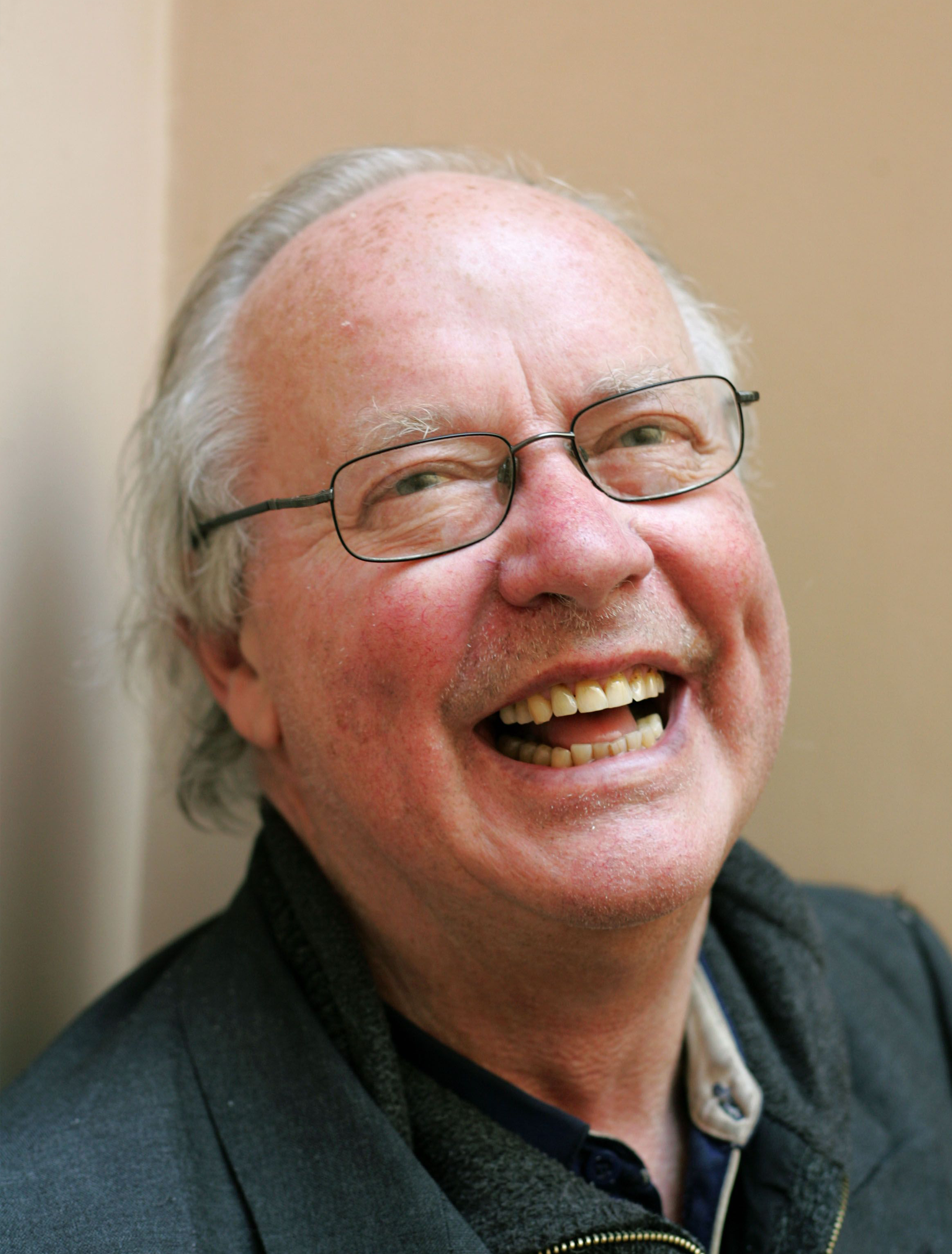 Brendan Kennelly photograph by Frank Millar © The Irish Times
Brendan Kennelly photograph by Frank Millar © The Irish Times
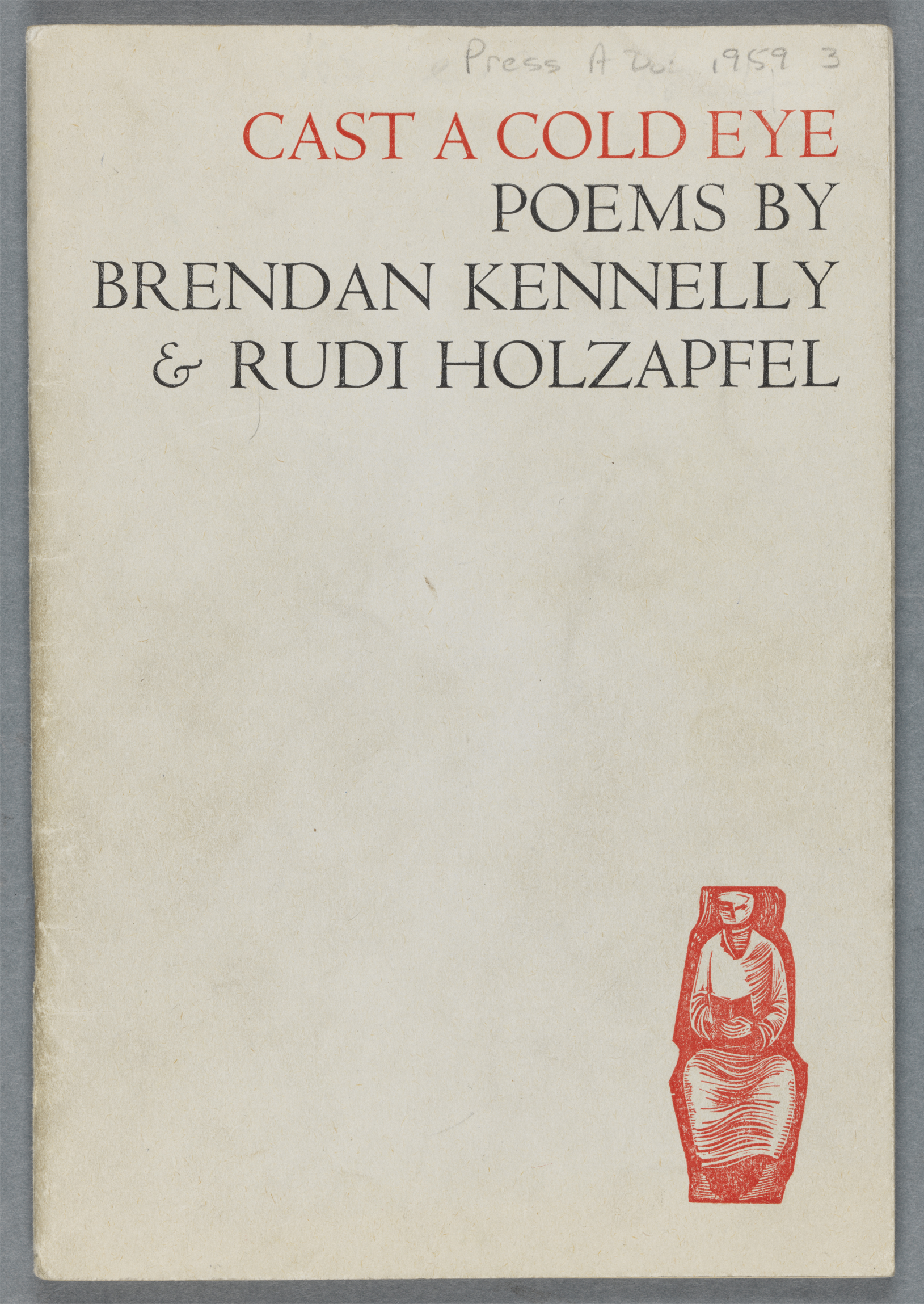 Brendan Kennelly and Rudi Holzapfel, Cast a Cold Eye (Dublin: Dolmen Press, 1959) (Press A Dol 1959 3). By permission of the Board of Trinity College Dublin.
Brendan Kennelly and Rudi Holzapfel, Cast a Cold Eye (Dublin: Dolmen Press, 1959) (Press A Dol 1959 3). By permission of the Board of Trinity College Dublin.
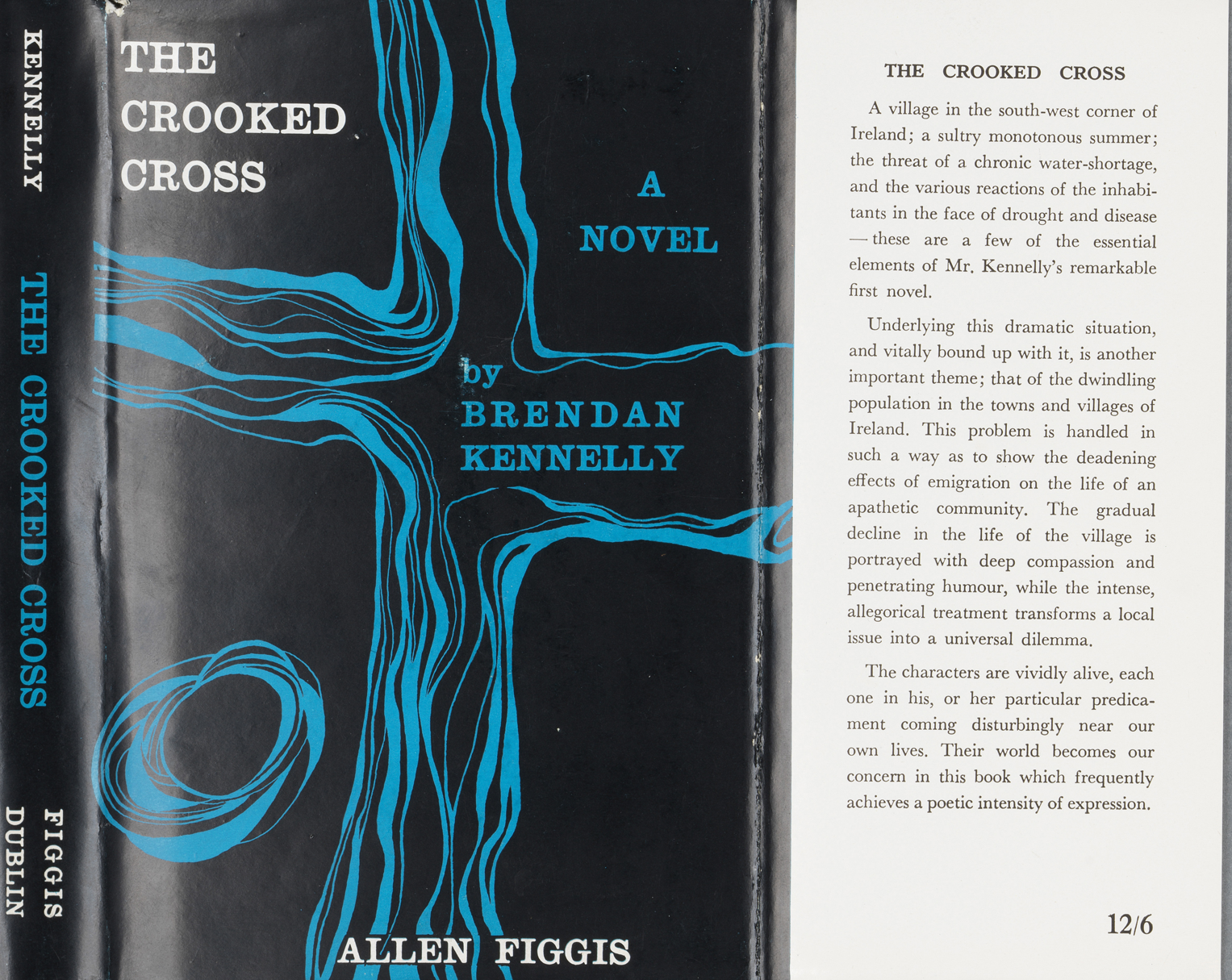 Brendan Kennelly, The Crooked Cross (Dublin: Allen Figgis, 1963) (OLS-B-7-883). Front dust cover. By permission of the Board of Trinity College Dublin.
Brendan Kennelly, The Crooked Cross (Dublin: Allen Figgis, 1963) (OLS-B-7-883). Front dust cover. By permission of the Board of Trinity College Dublin.
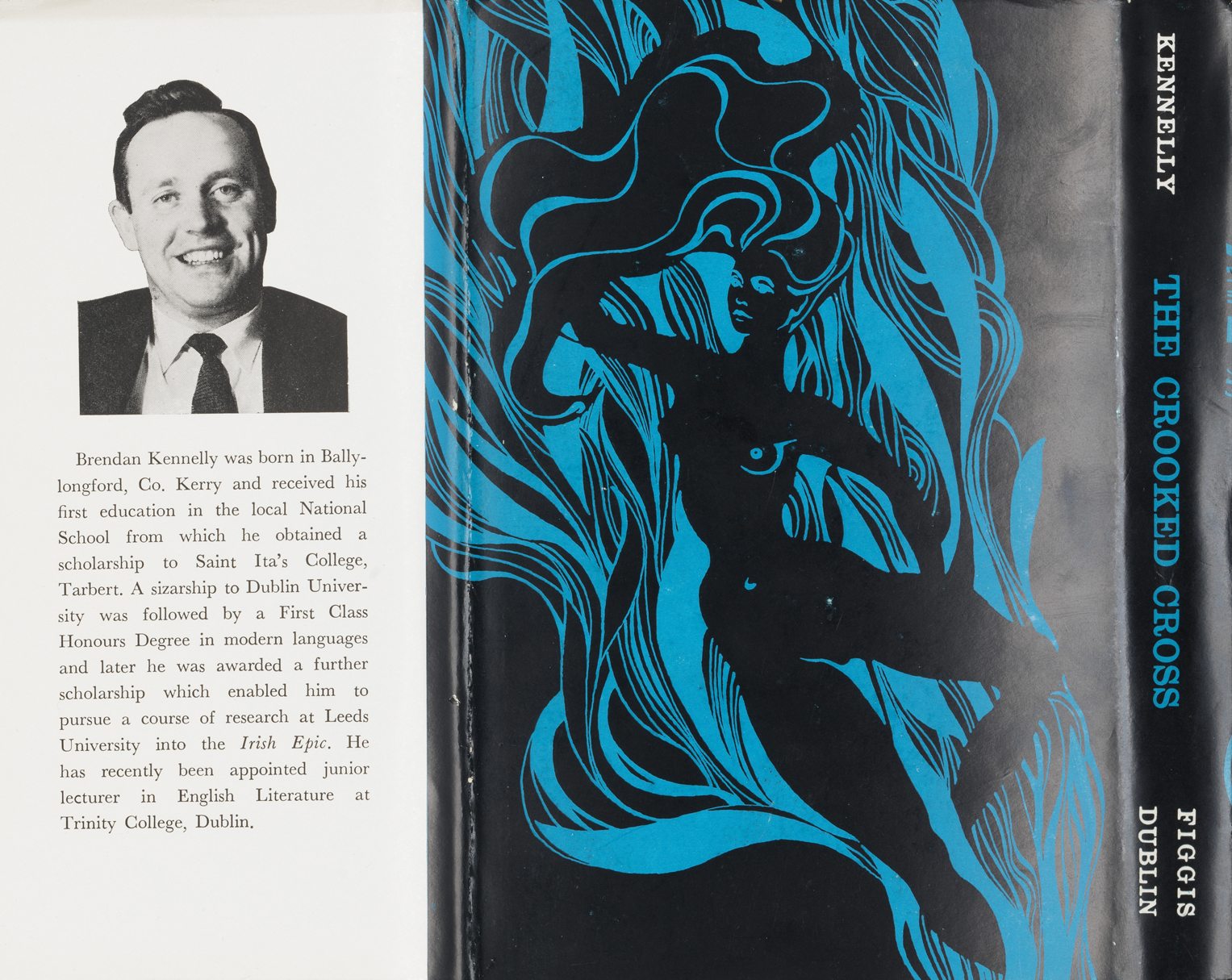 Brendan Kennelly, The Crooked Cross (Dublin: Allen Figgis, 1963) (OLS-B-7-883). Front dust cover. By permission of the Board of Trinity College Dublin.
Brendan Kennelly, The Crooked Cross (Dublin: Allen Figgis, 1963) (OLS-B-7-883). Front dust cover. By permission of the Board of Trinity College Dublin.
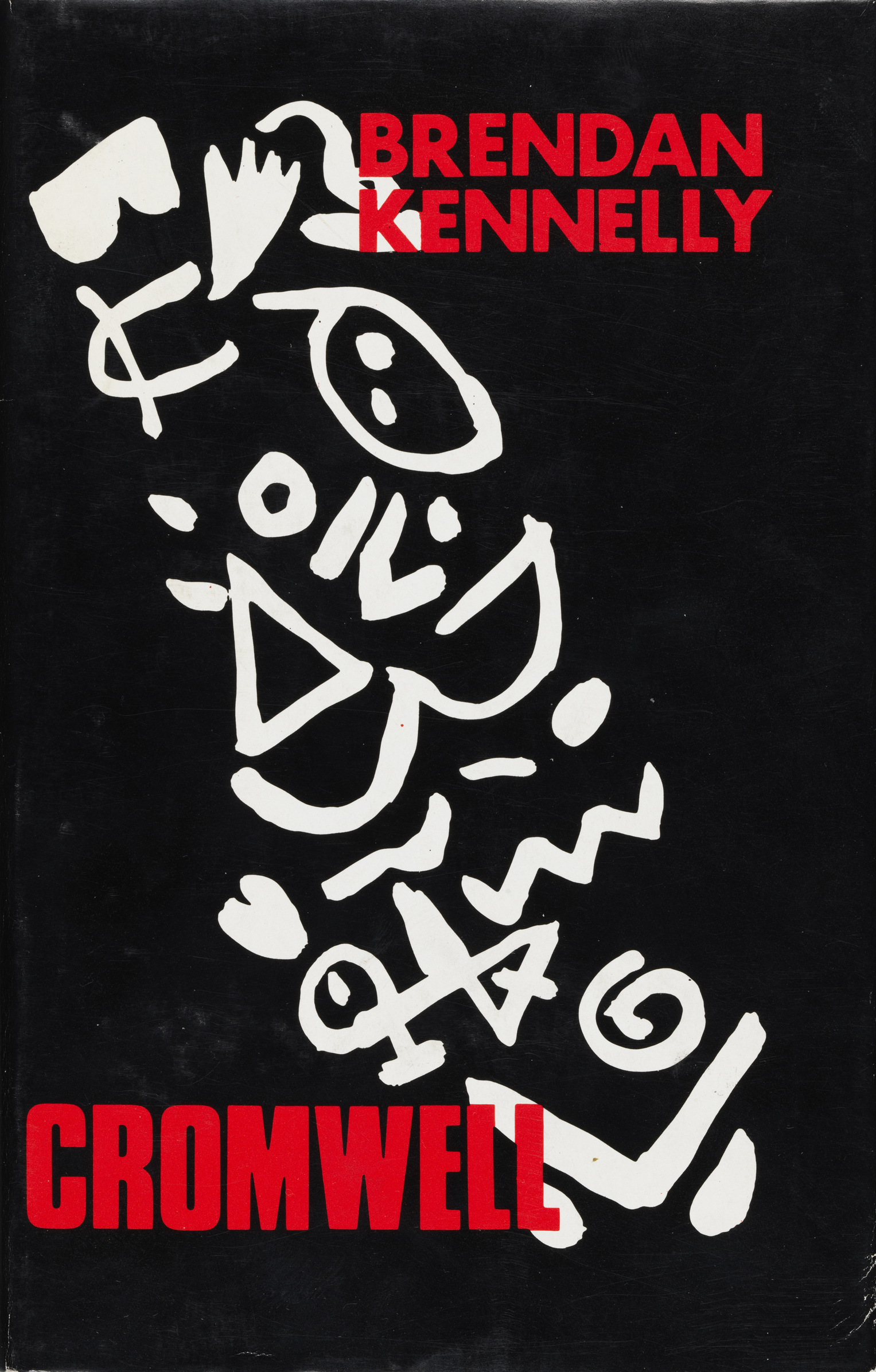 Brendan Kennelly, Cromwell: A Poem (Dublin: Beaver Row, 1983) (OLS-L-1-783). By permission of the Board of Trinity College Dublin.
Brendan Kennelly, Cromwell: A Poem (Dublin: Beaver Row, 1983) (OLS-L-1-783). By permission of the Board of Trinity College Dublin.
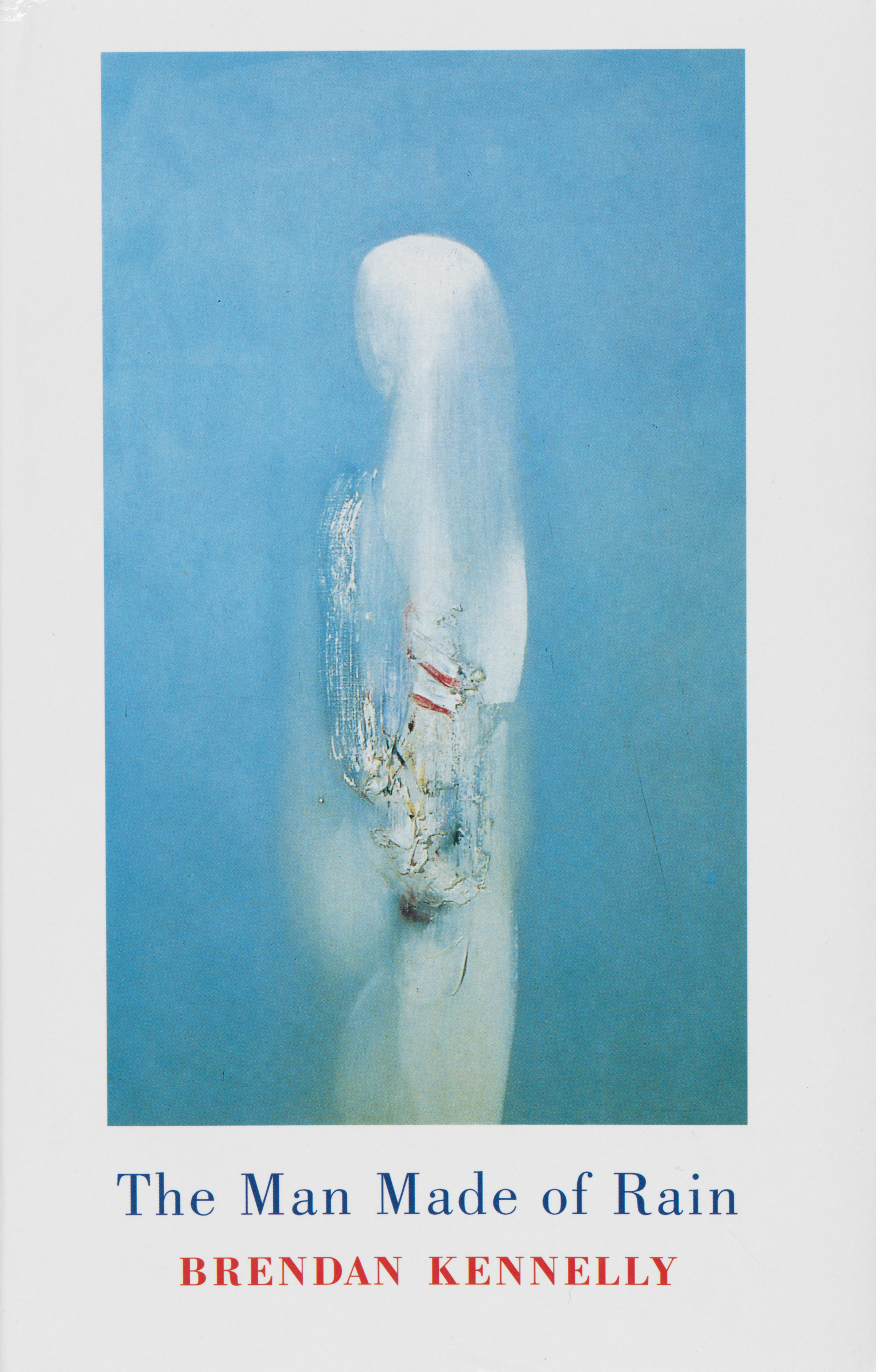 Brendan Kennelly, The Man Made of Rain (Newcastle upon Tyne: Bloodaxe Books, 1998)
Brendan Kennelly, The Man Made of Rain (Newcastle upon Tyne: Bloodaxe Books, 1998)
 Brian Bourke, Brendan Kennelly, from a series of 9 portrait sketches, 30 x 28.5 cm, Trinity College Dublin Art Collections. Reproduced by kind permission from The Board of The University of Dublin, Trinity College Dublin, Ireland. ©the artist
Brian Bourke, Brendan Kennelly, from a series of 9 portrait sketches, 30 x 28.5 cm, Trinity College Dublin Art Collections. Reproduced by kind permission from The Board of The University of Dublin, Trinity College Dublin, Ireland. ©the artist
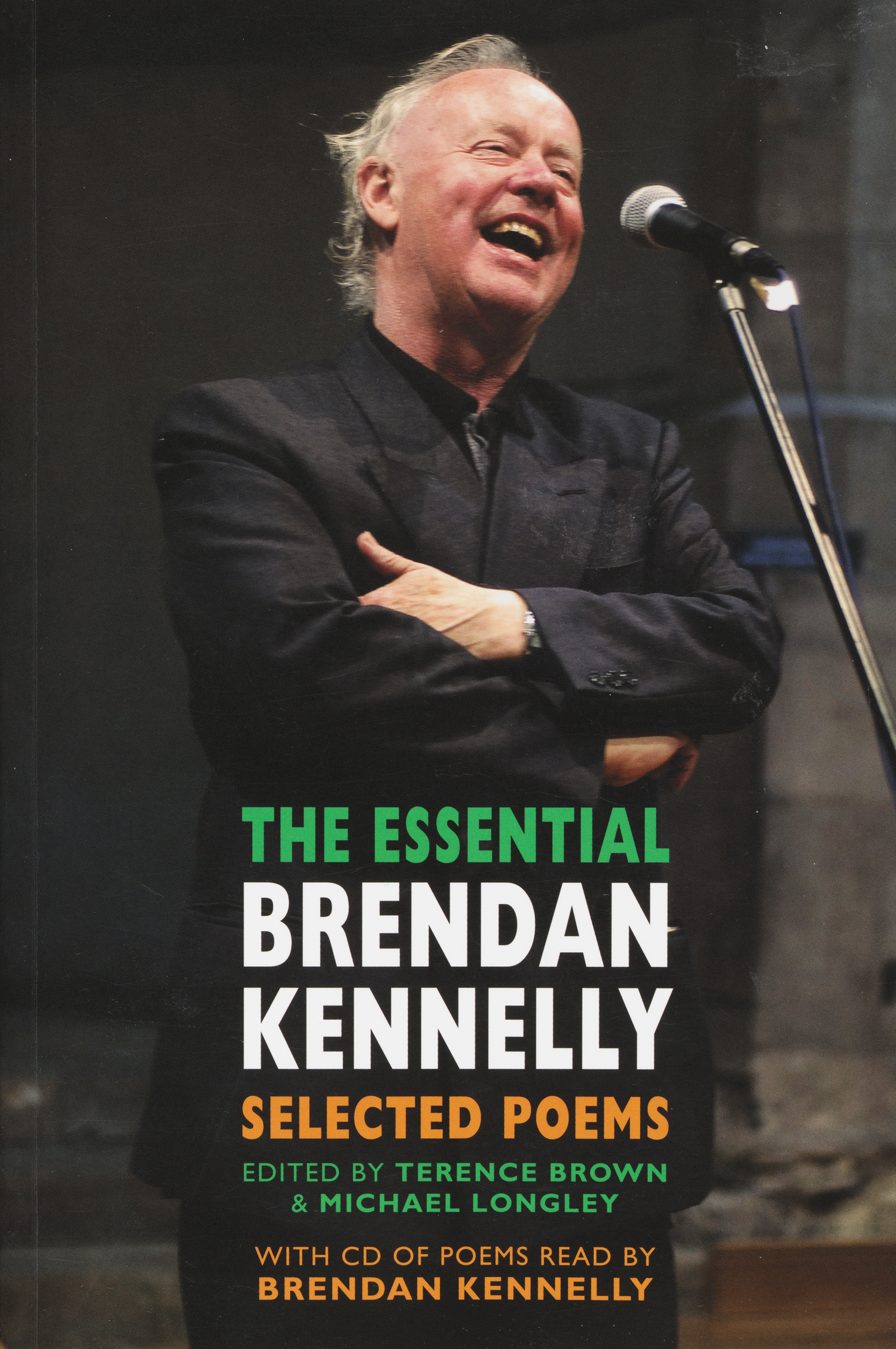 The Essential Brendan Kennelly, ed. Terence Brown and Michael Longley (Newcastle upon Tyne: Bloodaxe Books, 2011)
The Essential Brendan Kennelly, ed. Terence Brown and Michael Longley (Newcastle upon Tyne: Bloodaxe Books, 2011)

